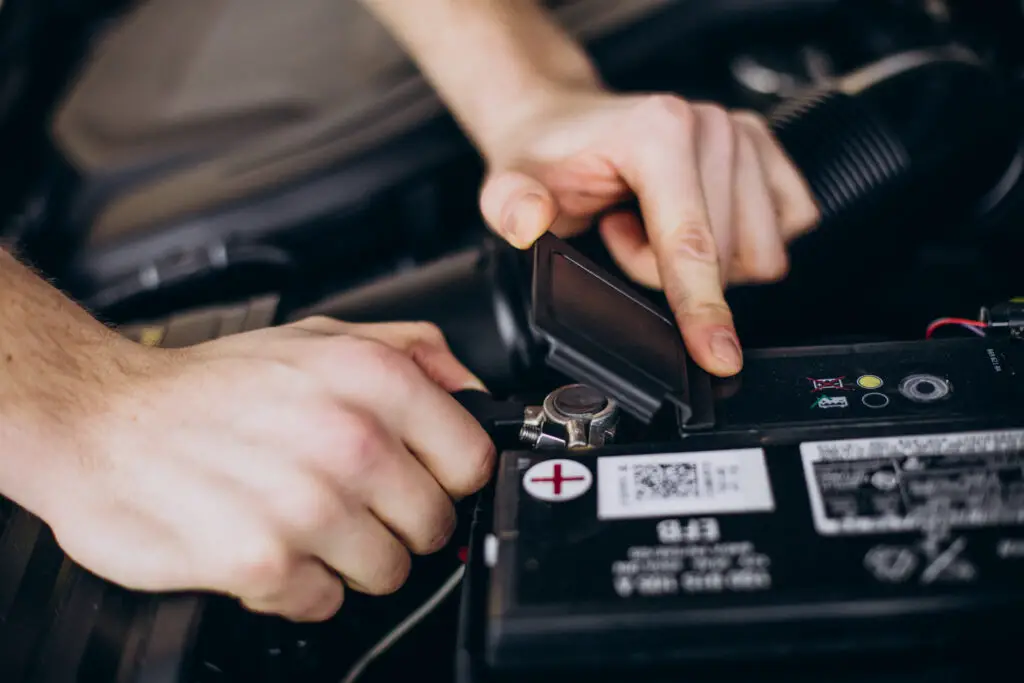Which battery terminal to disconnect when working on car? When it comes to working on your car, ensuring safety and preventing electrical mishaps is crucial. One essential step before starting any work on your vehicle’s electrical system is disconnecting the battery.
But if you’re new to car maintenance or unsure of the proper procedure, you might wonder: Which battery terminal should you disconnect first?
In this comprehensive guide, we’ll explore why disconnecting the battery is important, the correct procedure for disconnecting terminals, and tips to ensure a safe and successful maintenance experience.
Why Disconnect the Battery?
When working on your car, safety should always be your top priority. One fundamental step in ensuring a safe and trouble-free maintenance experience is disconnecting the battery. The car’s battery powers a multitude of electrical systems, from the engine’s ignition to the interior lights.
Safety First
Disconnecting the battery is a fundamental safety measure when working on your car. The electrical system in modern vehicles is complex, and touching the wrong components can lead to short circuits, electrical shocks, or damage to sensitive electronics.
By disconnecting the battery, you minimize the risk of accidental electrical discharge and protect both yourself and your vehicle’s components.
Preventing Electrical Issues
Disconnecting the battery prevents accidental activation of electrical components while you’re working on the car. For example,
if you’re replacing a component or working near the engine, accidental contact with live wires could cause sparks or damage sensitive electronic systems. Disconnecting the battery ensures that no power flows through the system while you’re working.
Protecting the Vehicle’s Electronics
Modern cars are equipped with a range of electronic systems, including computers, sensors, and control modules. These components can be sensitive to electrical surges or shorts.
By disconnecting the battery, you protect these systems from potential damage that could result from accidental contact or incorrect handling during maintenance.
Which Terminal to Disconnect?
A car battery has two terminals: the positive terminal (marked with a “+” sign) and the negative terminal (marked with a “-” sign). Each terminal plays a different role in the vehicle’s electrical system:
- Positive Terminal (+): This terminal carries the positive charge from the battery to the car’s electrical system.
- Negative Terminal (-): This terminal is connected to the car’s ground and completes the circuit by providing a return path for the electrical current.

Recommended Procedure
1. Disconnect the Negative Terminal First
When it comes to disconnecting the battery, the general recommendation is to start by removing the negative terminal. Here’s why:
- Safety Considerations: The negative terminal is connected to the vehicle’s ground, which means that when it is disconnected, there is no return path for the current. By removing this terminal first, you minimize the risk of creating a short circuit if you accidentally touch a metal tool to the battery’s positive terminal or another metal part of the car.
- Preventing Short Circuits: If you accidentally touch the positive terminal with a metal tool while the negative terminal is still connected, it could create a short circuit. Removing the negative terminal first reduces this risk by breaking the circuit and isolating the battery from the car’s electrical system.
2. Disconnect the Positive Terminal Second
After the negative terminal has been safely disconnected, you can proceed to remove the positive terminal. This is the final step in the process of disconnecting the battery:
- Completing the Disconnection: With the negative terminal already removed, the positive terminal can be safely disconnected without risking a short circuit. Ensure that the positive terminal is properly secured and kept away from any metal parts to avoid accidental contact.
Reconnecting the Battery
When you’re ready to reconnect the battery, the procedure is essentially the reverse of disconnecting:
- Reconnect the Positive Terminal First: Attach the positive terminal to the positive battery post and tighten it securely.
- Reconnect the Negative Terminal Second: Attach the negative terminal to the negative battery post and tighten it securely.
By following this order, you ensure that the circuit is properly completed and reduce the risk of accidental short circuits.
Additional Tips for Battery Maintenance
Use the Right Tools
When working with battery terminals, use the appropriate tools to avoid damaging the terminals or the battery.
A wrench or socket set is usually required for loosening and tightening the terminal bolts. Avoid using excessive force, as this can damage the battery terminals or connectors.
Inspect the Battery and Terminals
While you’re working on the battery, take the opportunity to inspect it for any signs of damage or wear. Check for corrosion around the terminals, which can appear as a white, powdery substance.
Clean any corrosion with a mixture of baking soda and water, and use a wire brush to gently scrub the terminals. Ensure that the battery terminals are tight and free of debris.
Wear Safety Gear
Always wear appropriate safety gear when working with the battery, including gloves and safety glasses. Batteries contain sulfuric acid and can release gases that are hazardous to your health. Proper safety gear helps protect you from accidental spills or fumes.
Avoid Sparks and Open Flames
When working on the battery, avoid creating sparks or working near open flames. Batteries can emit flammable gases and sparks or flames can ignite these gases, leading to dangerous explosions. Work in a well-ventilated area and ensure that no ignition sources are present.
Conclusion
Disconnecting the battery is a crucial step in safely performing maintenance on your car’s electrical system. By following the correct procedure—disconnecting the negative terminal first and the positive terminal second—you can minimize the risk of electrical shorts, protect your vehicle’s electronics, and ensure a safe working environment.
Remember to use the right tools, inspect the battery for any issues, and wear appropriate safety gear to protect yourself during the process. With these precautions in mind, you’ll be better prepared to handle car maintenance tasks with confidence and safety.
Discover more from Chikwem
Subscribe to get the latest posts sent to your email.